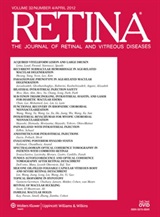Questo studio giapponese conferma la validità della terapia intavitreale con Avastin per la maculopatia miopica. Viene confermata la peggiore prognosi visiva nell’interessamento subfoveale della membrana neovascolare.
Hayashi, Kengo MD; Shimada, Noriaki MD; Moriyama, Muka MD; Hayashi, Wakako MD; Tokoro, Takashi MD; Ohno-Matsui, Kyoko MD
Retina
April 2012 – Volume 32 – Issue 4 – p 687–695
Methods: An open-label, consecutive, interventional case series. Seventy-five eyes of 69 consecutive Japanese patients with either subfoveal or nonsubfoveal myopic CNVs were studied. The eyes were treated with intravitreal bevacizumab and followed-up for at least 2 years. The best-corrected visual acuities at the baseline in eyes with subfoveal CNV were compared with that in eyes with nonsubfoveal CNV at 2 years after the intravitreal bevacizumab.
Results: The difference between the mean best-corrected visual acuity at the baseline and that at 2 years in eyes with a subfoveal CNV was not significant. However, the mean best-corrected visual acuity in eyes with nonsubfoveal CNV was significantly improved from 0.53 ± 0.36 logarithm of the minimal angle of resolution units (Snellen 20/66) before intravitreal bevacizumab to 0.29 ± 0.36 logMAR units (Snellen 20/40) (P < 0.001) 2 years after intravitreal bevacizumab. The incidence of chorioretinal atrophy after 2 years was 3 of 49 (6.1%) in eyes with nonsubfoveal CNV and 21 of 26 (80.8%) in eyes with which subfoveal CNV (P < 0.001). Furthermore, the chorioretinal atrophy area with nonsubfoveal CNV was 0.05 ± 0.21 mm2, which was also significantly smaller than that of subfoveal CNV at 1.76 ± 1.60 mm2 (P < 0.001).
Conclusion: Intravitreal bevacizumab is a good treatment for eyes with nonsubfoveal CNV; however, another treatment is necessary for eyes with a subfoveally located CNV.

